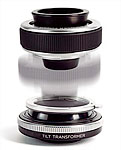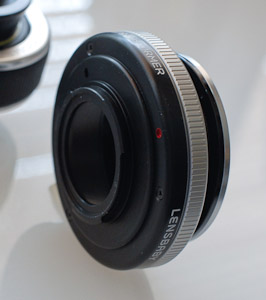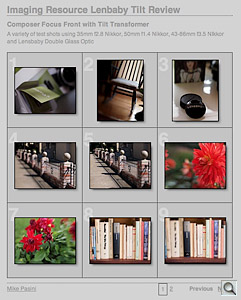USE A NIKON LENS OR THE OPTIC SWAP SYSTEM
Lensbaby Goes Mirrorless -- Tilt!

By MIKE PASINI
Editor
The Imaging Resource Digital Photography Newsletter
Review Date: September 2010
With the announcement of its new Lensbaby Composer with Tilt Transformer, Lensbaby brings its unique special effects lenses to mirrorless cameras. The first mount available is for Micro Four Thirds cameras but by the end of October, Lensbaby promised a version for Sony NEX mirrorless cameras as well.
According to some estimates, mirrorless cameras make up about 40 percent of the Japanese market, eight percent of the European market and six percent of the American market. The mirrorless advantage of a more compact body than a dSLR without the drop in quality of compact digicams makes it a welcome companion almost anywhere outside the studio. And that covers a lot of ground.
A TILT LENS | Back to Contents
But Lensbaby is bringing more than its innovative Optic Swap system of special effects lenses to mirrorless cameras. Thanks to the smaller sensor of the Micro Four Thirds and NEX systems, it's also bringing a tilt system compatible with Nikon's 35mm F mount.

Front & Tilt. The Composer Front Focus (left) and the Tilt Transformer (right) shown in front of a 35mm Nikkor.
The new product required a redesign of the classic Composer, separating the optic holder (or Composer Focus Front) from the swivel section. Lensbaby calls this a two-in-one design because you can use the optic holder with most of the Optic Swap options or you can pop a Nikkor or Nikon-compatible lens on the swivel section instead. The swivel mounts to either using Nikon's F mount.
That gets you a slice of focus whose width you manipulate with the Nikkor's aperture (the wider the aperture, the thinner the slice). The tilt is up to twice as far as standard tilt-shift lenses, Lensbaby claims. And a built-in mechanism lets Nikon G lenses without an aperture ring function at any aperture.

Tilt Transformer. Micro Fout Thirds mount. Mouse over to the see the metal Nikon F mount. Note the red alignment guides.
In the field, tilt lets you focus on subjects in different planes of the scene, somewhat like a view camera or tilt-shift lenses.
Available immediately for Micro Four Thirds cameras like the Panasonic Lumix G and Olympus PEN cameras, Lensbaby also announced a Sony NEX version for the last quarter of 2010.
The two pieces of this lens set come in two boxes wrapped in a cardboard holder like other Lensbaby product. It's very nicely designed packaging, suitable for storage as well.
The shallower Tilt Transformer includes a velvet storage bag while the Composer Focus Front includes a bag, lens cap and the aperture disc set tucked inside the aperture removal tool. Both units include printed documentation.
No removal tool is included with the Front. Presumably you don't need one until you own a second Optic Swap element, which is housed in a plastic case whose top is also the removal tool.
The Front ships with a Double Glass Optic installed. You can also use Single Glass, Plastic, Pinhole/Zone Plate and Soft Focus lenses in the Optic Swap system. The Fisheye optic is not compatible with the Composer with Tilt Transformer.

Composer Front Focus. The Optic Adapter is mounted on the Double Glass optic. Mouse over to see F mount on back with red alignment dot.
Our configuration of both the Composer Front Focus and the Tilt Transformer lists for $350. But you can also buy just the Tilt Transformer for $250, using it with Nikon F mount lenses.
SPECIFICATIONS | Back to Contents
The Lensbaby Composer itself is a manual focus lens based on a ball and socket design that delivers smooth selective focus. You simply tilt the lens and then focus with the manual focusing ring. The Composer holds its position without a locking mechanism.
Tilt Transformer product specs and features include:
- Available immediately for Panasonic Lumix G Micro Series and Olympus PEN digital cameras and in Q4 2010 for Sony Alpha NEX cameras
- When used with a Nikon mount lens, produces a slice of focus through the image
- Width of focus slice is dependent upon aperture -- f1.4 will produce a very thin slice of focus with abundant blur, while f22 will produce a very wide slice of focus with just a tiny bit of blur. Extreme tilt at a very bright aperture will make that slice appear even thinner
- Tilts up to twice as far as standard tilt-shift lenses making it possible to achieve more extreme blur falling off of a very thin slice of selective focus, as compared to the usual slice of focus width and focus fall-off of a typical tilt-shift lens
- Built-in mechanism allows Nikon G lenses, which do not have an aperture ring, to function properly at all apertures. The mechanism allows the aperture to open and close by manually rotating the lens.
- High quality metal swivel ball for smooth, fluid tilt
- Easy grip, metal locking ring controls ease of adjusting tilt
- All metal, precision construction
Composer with Tilt Transformer specs and features includes the Tilt Transformer specifications above plus:
- Ships with the Double Glass Optic and optical adapter installed
- Aperture can be changed using the included aperture disks from f1.6 with no disk installed to f1.8, f2.8, f4, f5.6, f8, f13, f22
- Supports the Lensbaby Optic Swap System when using the included Optic Adapter, allowing photographers to swap out the Double Glass
- Optic Adapter reduces actual focal length of above lenses to ~40mm (~80mm effective focal length), allowing them to focus at infinity
- Aperture Type: Interchangeable levitating (magnetic) aperture disks
- Minimum focus of approximately 12 inches and maximum focus at infinity
Note that the Fisheye optic is not compatible with the Composer with Tilt Transformer.
We took the new Composer with Tilt Tranformer for a test drive. Several test drives, in fact. We kept coming up with new ways to use it.

Composer & Tilt. Mounted on the E-PL1.
We mounted the Tilt Transformer on an Olympus PEN E-PL1 Micro Four Thirds camera. In addition to the Composer Focus Front, we also used a 50mm f1.4 Nikkor, a 35mm f2.8 Nikkor and a 43-86mm f3.5 Nikkor.
To get down to business, we mounted the Front to the Transformer by aligning the small red dot on the silver back rim of the Front to the red slit on the Transformer. Then we mounted the set on the E-PL1 by aligning its red dot with the camera's red dot on its silver mounting surface.

Nikkor & Tilt. Mounted on the E-PL1.
Mounting a Nikkor was just as easy. Just match the red indicators to seat and then twist to lock, as you would with any removable lens.
The Tilt has a small metal tab to release its locking mechanism when you want to remove a lens. Just press it toward the camera body and rotate the lens to release it from the Tilt.
Before slapping the back cover on the Front, be sure to rotate the Optic Swap element inward. It can protrude too far out for the cover to seat.
COMPOSER FRONT FOCUS | Back to Contents
While the Tilt is pretty straightforward with no optical element, the Front is a set of three pieces you occasionally have to dissemble.

Front Dissembled. The Composer Front Focus dissembled into the Composer (left), Double Glass optic (center) and Optic Adapter (right).
The three parts to the Front are:
- The housing itself, which mounts to the Tilt via the Tilt's Nikon F Mount (which, by the way, should never be mounted to a Nikon dSLR because it would bang into the mirror)
- The interchangeable Optic Swap element (with an aperture disc)
- The Micro Four Thirds optical adapter, which reduces the focal length of Optic Swap lenses to about 40mm from 80mm for these cameras whose lenses are closer to the sensor than dSLRs
We dissembled the front to have a closer look.
The Optic Adapter, which looks like a mini lens hood, screws off. The Optic Swap element requires a tool to insert into the three holes along its rim. You then depress the tool slightly and rotate the element free of its locking tabs so it falls out.
Changing aperture discs does not, it's worth noting, expose your sensor to the elements. The Optic Swap optics are behind the aperture, so the sensor area remains sealed.
But changing Optic Swap optics does expose your sensor on a mirrorless camera, so take precautions against wind and dust.
Without the Optic Adapter, it should also be noted, you won't achieve focus on a mirrorless camera.
IN THE FIELD | Back to Contents
The E-PL1's continuous Live View focusing shows you exactly what either type of lens is focused on as you manipulate the front element of this duo.
To set focus, two guides are all you need:
- Moving the lens from left to right or up and down sets focus in the direction you move.
- The more open the aperture, the thinner the slice of focus is.
That's pretty much what you would expect. You'd point the lens at what you want focused and close down the aperture to increase sharpness. And here you aim the lens at what you want in focus and open the aperture to increase blur.
Manipulating the aperture is a lot more fun with a Nikkor than with the Front, of course. The Front requires removing the optical adapter to swap aperture discs while the Nikkor has an aperture ring.
A built-in mechanism allows Nikon G lenses, which do not have an aperture ring, to use any aperture, according to Lensbaby. To change apertures, you manually rotate the lens.
Our 43-86mm Nikkor zoom was bit hard to manage, despite its compact size. Larger lenses are certainly possible (tighten down the locking mechanism on the Tilt so they don't sag from their own weight), but they left us longing for a third hand.
The other issue that bedeviled us was the E-PL1's LCD. We thought we could read focus on it, but we couldn't completely see what the lens was doing. We typically thought more was in focus than, in fact, was in focus.
Our workaround was to use the E-PL1's magnify option to enlarge a part of the LCD. That made focus much easier but it made composition more difficult. So while you get some view camera functionality, you may really miss the old ground glass.
Our gallery of sample shots shows some of the still effects achievable at wide open and closed down apertures with both the Composer and Nikkor lenses. But we also shot movies using the 43-86mm zoom. We didn't rehearse, but it's a good idea. You can shift focus from one element in the scene to another and recompose the scene with the zoom.
Apart from our problem focusing with the E-PL1, the Lensbaby itself was great fun. That was particularly true with a Nikkor mounted to the Tilt. But it's worth the price of admission just to have the Optic Swap system available on a mirrorless compact. Either way, you'll never get bored.
Our initial gallery shots beg to be expanded to include more of the Optic Swap lenses and more lens information (something not recorded in the Exif header with this gear).
Meanwhile they do suggest some possibilities the Tilt Transformer with the Composer Front Focus or a Nikon lens can add to your portfolio.

